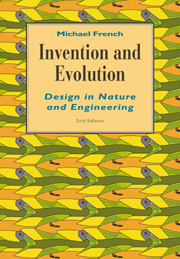Book contents
- Frontmatter
- Contents
- Preface to the second edition
- Preface to the first edition
- Acknowledgements
- 1 The designed world
- 2 Energy
- 3 Materials
- 4 Mechanism
- 5 Structures
- 6 Systems
- 7 The practice, principles and philosophy of design
- 8 Economy, form and beauty
- 9 Production, reproduction, evolution and design
- 10 Designing and inventing
- 11 Some case studies
- Questions
- Answers
- Suggestions for further reading
- Index
4 - Mechanism
Published online by Cambridge University Press: 06 January 2010
- Frontmatter
- Contents
- Preface to the second edition
- Preface to the first edition
- Acknowledgements
- 1 The designed world
- 2 Energy
- 3 Materials
- 4 Mechanism
- 5 Structures
- 6 Systems
- 7 The practice, principles and philosophy of design
- 8 Economy, form and beauty
- 9 Production, reproduction, evolution and design
- 10 Designing and inventing
- 11 Some case studies
- Questions
- Answers
- Suggestions for further reading
- Index
Summary
Mechanism
The engineer and nature work with energy, materials and information. Three of the characteristics of the designs they produce are mechanism, structure and systems, common features of organisms which will be discussed in the next three chapters.
Mechanisms are familiar enough, in clocks, sewing machines, locks and catches, switches, the human hand, and so on. They can be considered as assemblages of simple elements, such as pivots and hinges, sliders, gears, and so on. Their functions generally are to transmit and modify forces and movements: the object of a door catch is to move a bolt under the action of a spring so that the door will be held closed, and to convert a turn of the handle into the retraction of that bolt when it is required to open the door. A door lock has a rather different function because it requires a very special kind of movement to withdraw the bolt, which depends on a knowledge of the code (in the case of a combination lock) or possession of a key which has the required movements coded into it. Historically, locks represent the human designer's first traffic in the third of his media, information, about 6000 years ago. They also exhibit, in a simple form, a crucial design principle, that of stereospecificity, that is, of actions like unlocking a door which depend on the interaction of components of very special shape.
- Type
- Chapter
- Information
- Invention and EvolutionDesign in Nature and Engineering, pp. 79 - 107Publisher: Cambridge University PressPrint publication year: 1994



